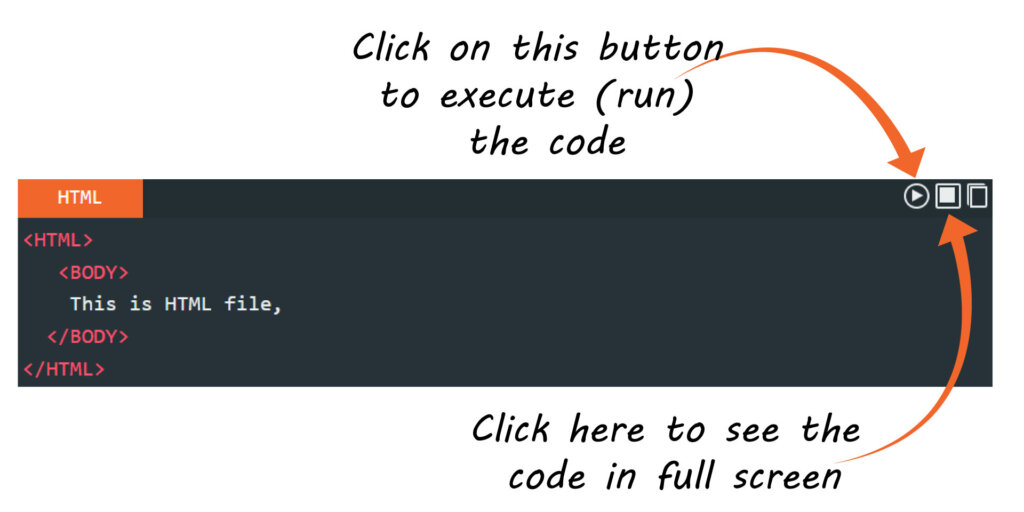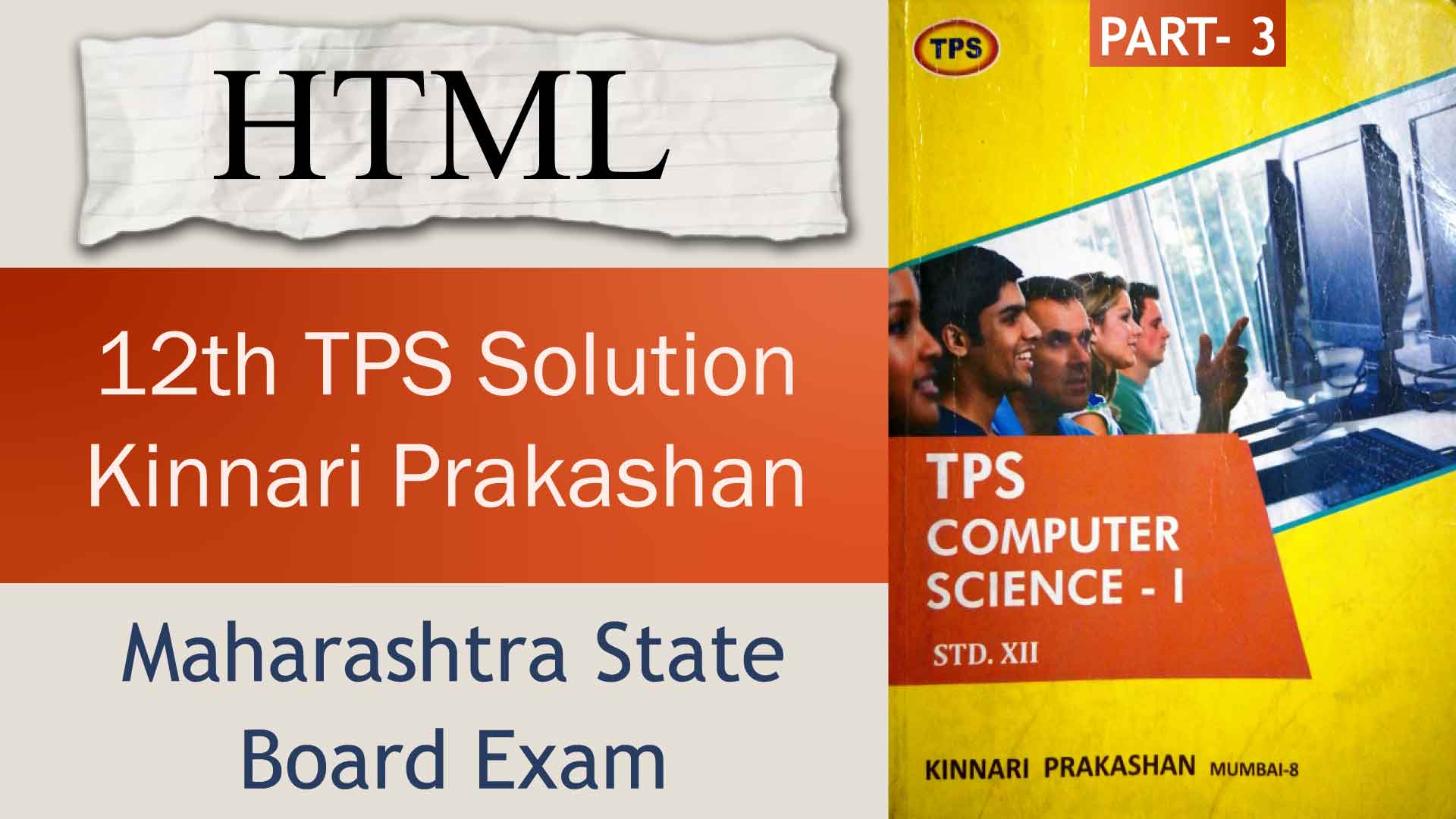Scope of the Syllabus
Probable marks : 14
Above probable marks means : In board exam questions asked form this chapter are nearly for 14 marks out of 50 Marks.
Scope of the Syllabus
1. Introduction to HTML.
2. Why HTML ? Its advantages and drawbacks.
3. Study of tags : <HTML>, <HEAD>, <TITLE>,<BODY>, <P>, <BR>, <UL>, <OL>, <PRE>, <MARQUEE>
4. Font styles : <B>, <I>, <U>, <BIG>, <SMALL>, <SUB>, <SUP>, <FONT>
6. Image : HREF, HR, <IMG>, SRC, ALT, HEIGHT, WIDTH, ALIGN
7. Tables: <TABLE>, <CAPTIONS>, <TR>, <TH>, <TD>
8. Use of scripting as a language support.
Note : Only VBscript using for….next, If … then, MsgBox, InBox, DIM, SET.

Q. 10 Explain the following tags in HTML :
(i) <P> tag
(ii) <BR> tag
(iii) <HR> tag
Ans :
(i) <p> tag :
1) <p> tag is used for creating paragraph of text.
2) A paragraph can be created by enclosing text within paragraph codes <p> and </p>
3) The browser ignores the paragraph created by user while writing codes by pressing, ‘Enter’. User must specifically define a paragraph in the code by using a Paragraph tag.
4) The <p> tag has one optional attribute called align. It is used to specify where the text appear on screen.
(i) <P align = left> Left alignment like normal text. </P> (ii) <P align = right> Text is aligned to right margin, but not justified to left. </P> (iii) <P align = center> Text is centered. </P> (iv) <P align = Justify> Text is justified to left and right margin. </P>
(ii) <BR> tag :
Ans:
1) <BR> tag insert line break into a text flow.
2) It tells the browser to wrap the text that follows onto a new line without inserting any extra space between the lines.
3) e.g.
Sonia Gandhi, <BR> 10 Janpath, <BR> New Delhi.
4) For an entire blank line <BR> tag on that line. For multiple blank lines, just count them and type
<BR> tag on every expected blank line.
(iii) <HR> tag :
1) A web page can be divided into separate sections by using horizontal rulers, <HR> tag.
It is also called as horizontal line.
2) This tag is mostly used for decorative purposes.
3) The <HR> tag takes several optional attribution. For example, to specify line width and how much of the browser’s window it should span (as a percentage) such as
<HR SIZE = "6" COLOR="red" WIDTH = "60%">
This displays a line of six pixels thick that spans 60 percent of the browsers windows: The default is to center in the window.
(iv) <PRE> tag
(1) <PRE> Is used to preformat the text. The text appearing between start <PRE> tag and end tag
</PRE> is displayed in mono space form.
(2) This tag is used to position the characters.
(3) This tag displays the text in exactly same format as the character and line spacing format defined in source HTML document.
(4) For example :
<PRE>
1
1 1
1 2 1
1 3 3 1
</PRE> Q. 11 How text is formatted by using <B> , <I> and <U> tags?
Ans :
To give additional emphasis to the text, HTML provides bold face, italics and underlining the words. This can be done by using <B> , <I> and <U> tags as :
(i) <B> tag :
<B> is bold tag. The text appearing between start tag (<B>) and end tag (</B>) will be displayed in bold letters.
e.g. <B> Bold Text </B>
ii) <I> tag :
<I> is italic tag. The text appearing between start tag (<I>) and end tag (</I>) will be displayed in italics.
e.g. <I> Italic Text </I>
iii) <U> tag :
<U> is underline tag. The text appearing between <U> and </U> tag will be underlined.
Generally, browser indicates hyperlinks in web pages by underlining them. So it is generally
avoided.
e.g.<U> underline text </U>.
Q.12 Explain the purpose of following tags in HTML with example.
(a) <marquee>
(b) <SUP>
(c) <HR>
(a) <marquee>
(1) It is used for scrolling the text and images on screen from right to left.
(2) The text written between start <marquee> tag and end </marquee> will scroll on screen in horizontal line.
For e.g. : <marquee> computer science </marquee>
(3) There are several attributes associated with such as BGCOLOR, HEIGHT and WIDTH.
(4) This is used to scroll the current news or position of different companies in stock market.
<marquee behavior="scroll" direction="right" scrollamount="5" bgcolor="yellow" width="90%">
This text will scroll from left to right within a yellow background.
</marquee>(b) <SUP> :
1) <SUP> is superscript tag.
2) The text enclosed within <SUP> (start tag) and </SUP> (end tag) is displayed in superscipt form.
For eg. : 2 <SUP> 2 </SUP> = 4
It will be displayed as : 2² = 4
(c) <HR> :
(1) <HR> tag is horizontal rule tag, also called as horizontal line.
(2) A web page can be divided into separate sections by using horizontal rule <HR> tag
(3) This tag is mostly used for decorative purposes.
(4) <HR> tag takes several attributes such as COLOR, SIZE, WIDTH etc.
For e.g. :
<HR SIZE = "6" COLOR="black" WIDTH = "60%">
This displays a line of six pixels thick that spans 60 percent of the browser’s window.
(5) The default is to center in the window.
eg : < HR NO SHADE > This means for an unshaded horizontal line.
Q. 13 What is tag <EM> ? What is the difference between <EM> tag and <I> tag ?
(Mar. 2013)
1) <EM> is emphasis tag. The text appearing between start tag (<EM>) and end tag (</EM>) will be displayed in italics. This tag is used to empasize the text.
2) The main difference between <EM> tag and <I> tag is that text to speech browsers given spoken emphasis to the text within emphasis tags, while no such emphasis is given to text within italic tags.
For eg: . <P> you <EM> must </EM> handover the money to him </P>
Q. 14 What is <Strong> tag ? What is the difference between <Strong> and <B> tags?
Ans :
(1) <Strong> is strong tag. The text appearing between start tag (<Strong>) and end tag (</Strong>) will be displayed in bold.
(2) This tag is used to create strong emphasis.
(3) The main difference between <Strong> and <B> tags is that the text to speech reader gives strident pronunciation to the strong text, while no such strident pronunciation given to bold text.
For eg. <P> If they don't give me that raise <STRONG> tomorrow </STRONG>, I quit </P>

